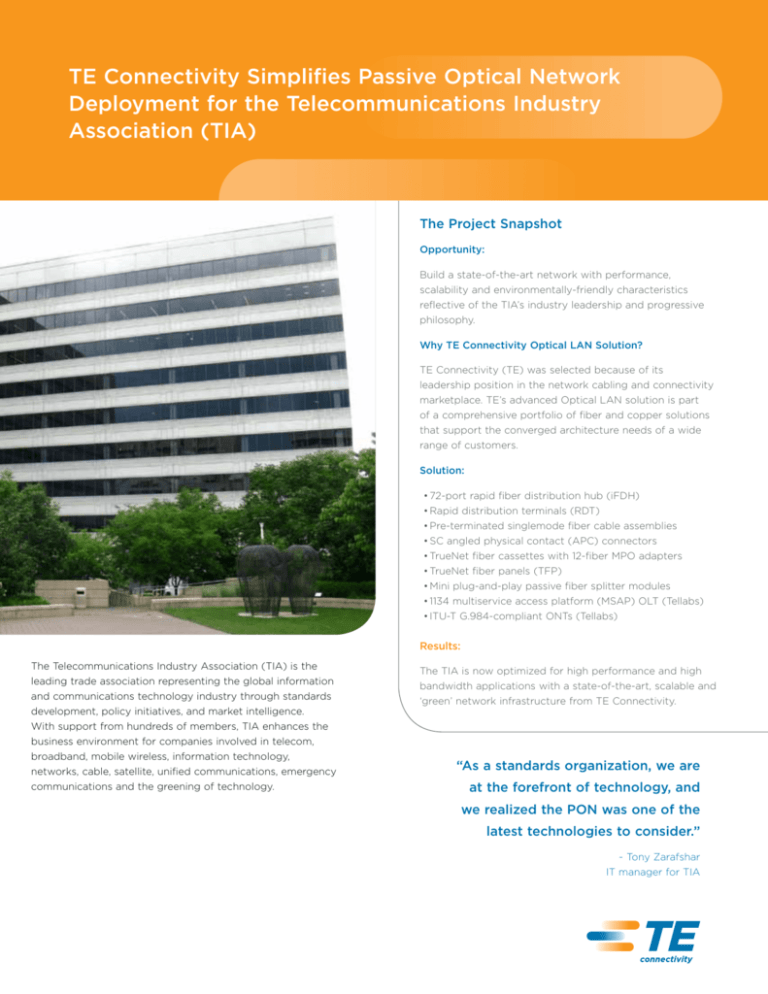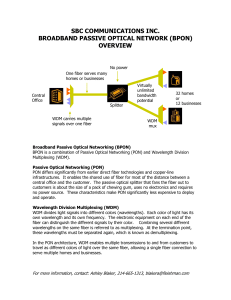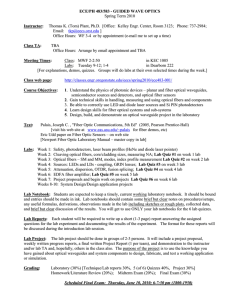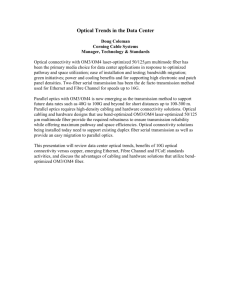
TE Connectivity Simplifies Passive Optical Network
Deployment for the Telecommunications Industry
Association (TIA)
The Project Snapshot
Opportunity:
Build a state-of-the-art network with performance,
scalability and environmentally-friendly characteristics
reflective of the TIA’s industry leadership and progressive
philosophy.
Why TE Connectivity Optical LAN Solution?
TE Connectivity (TE) was selected because of its
leadership position in the network cabling and connectivity
marketplace. TE’s advanced Optical LAN solution is part
of a comprehensive portfolio of fiber and copper solutions
that support the converged architecture needs of a wide
range of customers.
Solution:
• 72-port rapid fiber distribution hub (iFDH)
•Rapid distribution terminals (RDT)
•Pre-terminated singlemode fiber cable assemblies
•SC angled physical contact (APC) connectors
•TrueNet fiber cassettes with 12-fiber MPO adapters
•TrueNet fiber panels (TFP)
•Mini plug-and-play passive fiber splitter modules
•1134 multiservice access platform (MSAP) OLT (Tellabs)
•ITU-T G.984-compliant ONTs (Tellabs)
Results:
The Telecommunications Industry Association (TIA) is the
leading trade association representing the global information
and communications technology industry through standards
development, policy initiatives, and market intelligence.
With support from hundreds of members, TIA enhances the
business environment for companies involved in telecom,
broadband, mobile wireless, information technology,
networks, cable, satellite, unified communications, emergency
communications and the greening of technology.
The TIA is now optimized for high performance and high
bandwidth applications with a state-of-the-art, scalable and
‘green’ network infrastructure from TE Connectivity.
“As a standards organization, we are
at the forefront of technology, and
we realized the PON was one of the
latest technologies to consider.”
~ Tony Zarafshar
IT manager for TIA
Deploying a Passive Optical Network in a
Standards-Based Enterprise Environment
Once perceived as a niche application for highly secure government installations, passive optical networks (PONs) are now
gaining traction in the premise enterprise environment as a means to move fiber closer to the end user while speeding network
deployment, saving space and providing a greener, more sustainable infrastructure.
PONs are quickly making their way into a variety of high port-count environments, including hospitals, universities, campuses,
hotels, casinos, high occupancy buildings (e.g., call centers), and multi-tenant units. More recently, PONs are being deployed
in lower port-count environments due to the energy, space and maintenance savings. To showcase this upcoming technology
in a standards-based deployment, the Telecommunications Industry Association (TIA) recently implemented a PON at its
headquarters in Arlington, Virginia using TE Connectivity’s Optical LAN Solution (OLS) and Tellabs Optical LAN equipment.
The Basics
Sometimes referred to as a passive optical LAN, a PON is a point-to-multipoint architecture that employs unpowered optical
splitters to enable a single strand of singlemode fiber to serve multiple users (or devices). PONs leverage the distance and
bandwidth capabilities of singlemode fiber to deliver converged IP voice, video, data and building automation over the single
fiber strand, while enabling efficient management and utilization of bandwidth and offering measurable OpEx and CapEx
savings with green benefits.
A PON is comprised of an optical line terminal (OLT) in the data center or main equipment room (ER), optical network
terminals (ONTs) at the end user or device locations and a passive cabling infrastructure of singlemode fibers that use splitter
technology to “split” the single input path into multiple output paths. At the work area, an ONT terminates the singlemode
fiber and converts the signal to one or more twisted-pair copper outputs to interface with Internet protocol (IP) enabled
devices, including voice over IP (VoIP) phones, computers, card readers, cameras or wireless access points (WAPs).
Because a PON is passive, no power is required from the data center to the work area, which can translate into an energy
savings of up to 50 percent depending on the installation. Passive splitters replace traditional active switches and come in a
variety of options, including TE Connectivity’s OLS that integrates cross-connect patching and zone-type splitting to free up
a significant amount of square footage within a facility. In fact, in a PON deployment, multiple buildings can be served by one
Page 2
main ER. The lightweight, smaller diameter singlemode fiber
used to connect the PON components (i.e., OLT to ONT)
also uses less cabling material and requires less pathway
space and associated pathways materials such as cable tray
and penetrations. This combination of energy, space and
material savings has led to PONs being recognized as an
environmentally-friendly technology.
In addition to reducing the amount of active equipment and
associated power and cooling, space and material, PONs
offer a fast deployment. It is typically easier to install a single
fiber to the work area rather than the traditional process
of installing multiple homerun copper cables from the
telecommunications room (TR). By using TE’s plug-and-play
OLS components to distribute the singlemode fiber all the
way from the Tellabs OLT to the ONTs, the ease of installation
was especially realized at TIA headquarters.
When we first looked at PON, it wasn’t
about being green—it was more about
taking advantage of a new technology
and quickly installing a robust, scalable
network that offered some key benefits”
– Herb Congdon, associate vice president of technology
and standards development for TIA
An Advanced, Green Option
TIA, responsible for developing network cabling performance standards, carefully considered its options and strived to deploy
an advanced, emerging technology. They also wanted to take advantage of some of the newest technologies that their
member companies could offer.
“As a standards organization, we are at the forefront of technology, and we realized the PON was one of the latest
technologies to consider,” says Tony Zarafshar, IT manager for TIA. “While typically deployed for larger businesses, we decided
to go with a PON because it was a new, environmentally-friendly option that we were excited about.”
In addition to deploying a PON, the Association wanted to take advantage of a fiber-to-the-desk (FTTD) solution without the
need for optical network interface cards (NICs) installed in end devices. Because the singlemode fiber of the PON is converted
to copper at the ONT, typical copper-based NICs and other network end devices can easily connect to the network. “We
weren’t new to this type of technology since we had some FTTD at our old location. But with FTTD, we had to purchase
optical NICs for every server and computer,” says Bisrat Bainesagn, senior network manager for TIA. “With the PON, we have
four copper interfaces at each ONT and can now avoid that expense.”
Page 3
The project also demanded a
solution that would allow a fast
deployment due to time constraints.
By using TE’s plug-and-play OLS
solution, TIA was able to complete
the entire installation in less than
two weeks. “One of the great
benefits with this type of plugand-play PON solution is that
you really don’t need expert fiber
termination craftsman on site,” says
Charlie Fox of Vector Resources, the
design and installation contractor
for the installation. “Everything is
simply pulled from component to
component and plugged in. Another
time saver is the fact that the
comprehensive testing required with
a typical installation is eliminated.
Once the channel is up and running,
the ONTs provide an immediate loss
calculation on the fiber.”
Ultimately, the PON also
provided TIA with a sustainable,
environmentally-friendly installation.
“When we first looked at PON, it
wasn’t about being green—it was
more about taking advantage of
a new technology and quickly
installing a robust, scalable network
that offered some key benefits,”
says Herb Congdon, associate
vice president of technology and
standards development for TIA.
“In addition to singlemode fiber
being the closest thing to a future
proof media, PON allowed us to
reduce power consumption and raw
materials with fewer electronics and
just a few passive fiber runs rather
than multiple copper runs. “
As part of the installation, TIA
plans to acquire certification
for the network under the
emerging Sustainable Technology
Environments Program (STEP)
rating system that addresses
sustainable planning, design,
integration and operation of lowvoltage building and communication
technologies. In addition to the
energy, material and space savings
Page 4
Why Singlemode and APC Connectors?
PONs use wave division multiplexing (WDM) technology, which combines
multiple optical signals onto a single fiber strand by using different
wavelengths of laser light. This enables bidirectional communications over one
strand of optical fiber, using one wavelength for downstream transmission and
another for upstream. WDM transmission requires singlemode fiber due to its
higher bandwidth capacity. The smaller core of a singlemode fiber allows for
the propagation of only one path of light, so distortion from overlapping light
pulses is reduced. PON electronics are therefore singlemode fiber-based due
to the fiber’s higher bandwidth capacity and longer distance capabilities.
While the connection points in a PON can be a subscriber connector-ultra
physical contact (SC-UPC) type simplex connector, TE’s OLS uses angled
physical contact (APC) connectors to reduce reflections. When a PON
delivers radio frequency (RF) video signals, a third wavelength via WDM is
used. This introduces back reflectance at connection points. RF systems are
extremely sensitive to any back reflections from connectors—the reflected
signal back into the downstream signal causes degradation of that signal.
The physical difference between APC and UPC connectors is the end face
geometry. The APC ferrule end face radius is polished at an 8-degree angle,
while UPC connectors are polished with no angle. When light is reflected at
the flat connector interface of a UPC connector, it is reflected straight back
at the source, increasing the return loss value. However, when the same signal
passes through the APC connector, the angle causes the reflected light to
be reflected into the cladding. The angle of the APC end face reduces back
reflection in the 1500-nanometer and above wavelength range for proper
transmission of injected RF video stream (analog). Additionally, future PON
releases to support 10 Gb/s will utilize a higher wavelength of 1577, which
is also subject to back reflections. Planning now for the future with APC
connectors will avoid having to update connectors later.
Return Loss: ~14.7dB
Flat/UPC
Return Loss: >60dB
8-degree angle
APC
The flat connector interface of a UPC connector reflects light back at the source,
while the angle of the APC connector reflects the light into the cladding.
provided by the PON, TIA will also
seek to acquire credits for the reuse of
existing equipment and applications
that reduce paper consumption and
waste.
“Throughout the entire planning
process, we’ve taken sustainability
into account. We eliminated paperbased documentation, and we will be
deploying a variety of applications
that further reduce paper consumption
and waste, such as video conferencing
and remote monitoring capabilities
to reduce travel and associated
greenhouse emissions,” says Congdon.
Tellabs 1134 Multiservice Access Platform installed at TIA headquarters
A Plug-and-Play Deployment
To support more than 50 users and a variety of network devices, TIA selected TE’s 72-port Rapid Fiber Distribution Hub
(iFDH) that administers the fiber cable from the Tellabs OLT. The iFDH uses splitters to distribute the fiber out to three Rapid
Fiber Distribution Terminals (FDTs) that serve as compact consolidation points, and from there, to the Tellabs ONTs at the
workstation.
For the OLT located in the main data center, TIA selected Tellabs 1134 Multiservice Access Platform (MSAP). This feature-rich,
packet-based and high-bandwidth platform supports incoming voice and broadband services. From the OLT, singlemode fiber
pre-terminated to SC angled physical contact (APC) connectors plug into cassettes housed in TE’s TrueNet Fiber Panel (TFP)
that serves as the interconnection point. The back of each TFP cassette features a 12-fiber MPO adapter for simple plug-in of
the pre-terminated 12-fiber RapidReel feeder cable from the iFDH. Within the iFDH, the RapidReel feeder cable is stored on
a reel and only the distance needed to connect back to the TFP is reeled off while the remaining cable slack is stored within
the iFDH. As a result, there is no need to know exact cable lengths beforehand. The RapidReel can hold up to 152 meters (500
feet) of RapidReel feeder cable, allowing the iFDH to be located virtually anywhere within the building.
At the TE iFDH, the 12 single fibers of the RapidReel feeder cable support 3 Mini Plug-and-Play Splitter Modules and 9 passthrough fibers. TE’s splitter modules use advanced planar lightwave circuit (PLC) technology to split each of the three fibers
into 32 for a total of 96 fibers. PLC technology offers higher split ratios, more precise splitting of the light and a compact size
The TE Rapid Fiber Distribution Hub (iFDH)
installed at TIA headquarters.
Page 5
The FDT serves as a consolidation point
closer to the work areas.
Router
OLT
TFP Fiber Panel
FDH - Fiber Distribution Hub
Fiber Wall Plate
ONT
FDT
Fiber Distribution Terminal
TIA headquarters features a PON design using TE’s OLS which takes up less floor space and requires lesscable.
over traditional splitter technologies. In the iFDH, the 96 fibers cross connect back to 12-fiber MPO connectors for
simple plug-in of the pre-terminated RapidReel feeder cables from the FDTs that serve as consolidation points closer
to the work area.
At TIA headquarters, the three FDTs are mounted to cable trays close to the work areas they serve. Like the iFDH, the
FDTs also feature built-in RapidReels that hold either 12- or 24-fiber RapidReel feeder cables. These cables are pulled
back to the iFDH with the remaining stored at the FDT on the reel. Within each FDT, a localized patching field allows
for single fiber cables to be distributed to work area outlets for connecting to the Tellabs ONT.
At each work area, the Tellabs Desktop ONT features four copper interfaces that support 10/100/1000 BASE-T
Ethernet for data and VoIP. The ITU-T G.984-compliant 2.5 gigabit per second (Gb/s) downstream and 1.25 Gb/s
upstream interfaces can be used for connecting to a variety of devices, including laptops, personal computers,
telephones, printers and other peripheral devices. The Tellabs ONTs feature dynamic bandwidth allocation that allows
for modification of bandwidth distribution across the four ports. In addition, Tellabs stackable and scalable 24-port
1600-729GP Multi-Desk ONTs were used for connecting to telephones in meeting areas and WAPS throughout the
facility.
“One of the nice things about the ONTs we deployed is that they can provide a burst of bandwidth to any of the ports
as needed,” says Zarafshar. “The Tellabs ONTs also provide us with port-level management and monitoring so we can
easily control the bandwidth that each user receives.”
Page 6
A Showcase for Technology
In addition to the easy installation
that eliminated the need for field
termination of the optical fiber, TIA’s
new PON provides additional benefits
associated with fiber, including
resistance to electromagnetic and
radiofrequency interference (EMI/RFI)
and crosstalk, greater tensile strength
and virtually unlimited bandwidth.
“While copper technology has done
an excellent job of migrating and
keeping up with bandwidth demands,”
says Congdon, “for a person like me
who grew up as a ‘fiber guy,’ there is
definitely a certain level of excitement
to see a solution that effectively brings
optical fiber to the desk.”
The Tellabs ITU-T G.984-compliant ONTs mounted at each work area support a variety of
devices, including printers, telephones and computers feature dynamic bandwidth allocation
to provide a burst of bandwidth to any of the four ports as needed.
While other options exist for distributing singlemode fiber from an OLT to ONTs in a PON, TIA’s plug-and-play hub-andterminal infrastructure using TE’s OLS and Tellabs equipment took up the least amount of floor space, required the least
amount of cable, and provided the greatest scalability and flexibility. With fewer electronics and the plug-and-play features
of TE’s advanced OLS, the network will also offer TIA reduced troubleshooting and maintenance costs and reduced power
consumption for maximum sustainability over the life of the system.
From the extremely fast network deployment, to the energy, space, and material savings that meet the latest green initiatives,
TE is extremely proud to provide an industry-leading standards organization like TIA with an advanced passive optical network
infrastructure that offers overall reduced lifecycle costs. As a showcase for this advanced technology, the network has been up
and running perfectly since the end of 2012 with many compliments from both TIA users and visitors alike.
Joining the ranks of large government and big business facilities taking advantage of the latest in advanced PON technology,
TIA now has a truly state-of-the-art network with the flexibility and scalability to support both current and future applications
as they continue representing the technology industry through state-of-the-art standards development.
Page 7
Case Study
Contact us:
Greensboro, NC
USA 27409-8420
Tel: 1-800-553-0938
Fax: 1-717-986-7406
www.te.com/EnterpriseNetworks
TE Connectivity, TE connectivity (logo), Tyco Electronics, and TE (logo) are trademarks of the TE Connectivity Ltd. family of companies
and its licensors.
While TE Connectivity has made every reasonable effort to ensure the accuracy of the information in this document, TE Connectivity does
not guarantee that it is error-free, nor does TE Connectivity make any other representation, warranty or guarantee that the information is
accurate, correct, reliable or current. TE Connectivity reserves the right to make any adjustments to the information contained herein at
any time without notice. TE Connectivity expressly disclaims all implied warranties regarding the information contained herein, including,
but not limited to, any implied warranties of merchantability or fitness for a particular purpose. The dimensions in this document are
for reference purposes only and are subject to change without notice. Specifications are subject to change without notice. Consult
TE Connectivity for the latest dimensions and design specifications.
Tyco Electronics Corporation, a TE Connectivity Ltd. Company. All Rights Reserved.
317049AE 6/13 Original © 2012









